Mayr E.W., Pr?mel H.J., Steger A. (eds.) Lectures on Proof Verification and Approximation Algorithms
Подождите немного. Документ загружается.

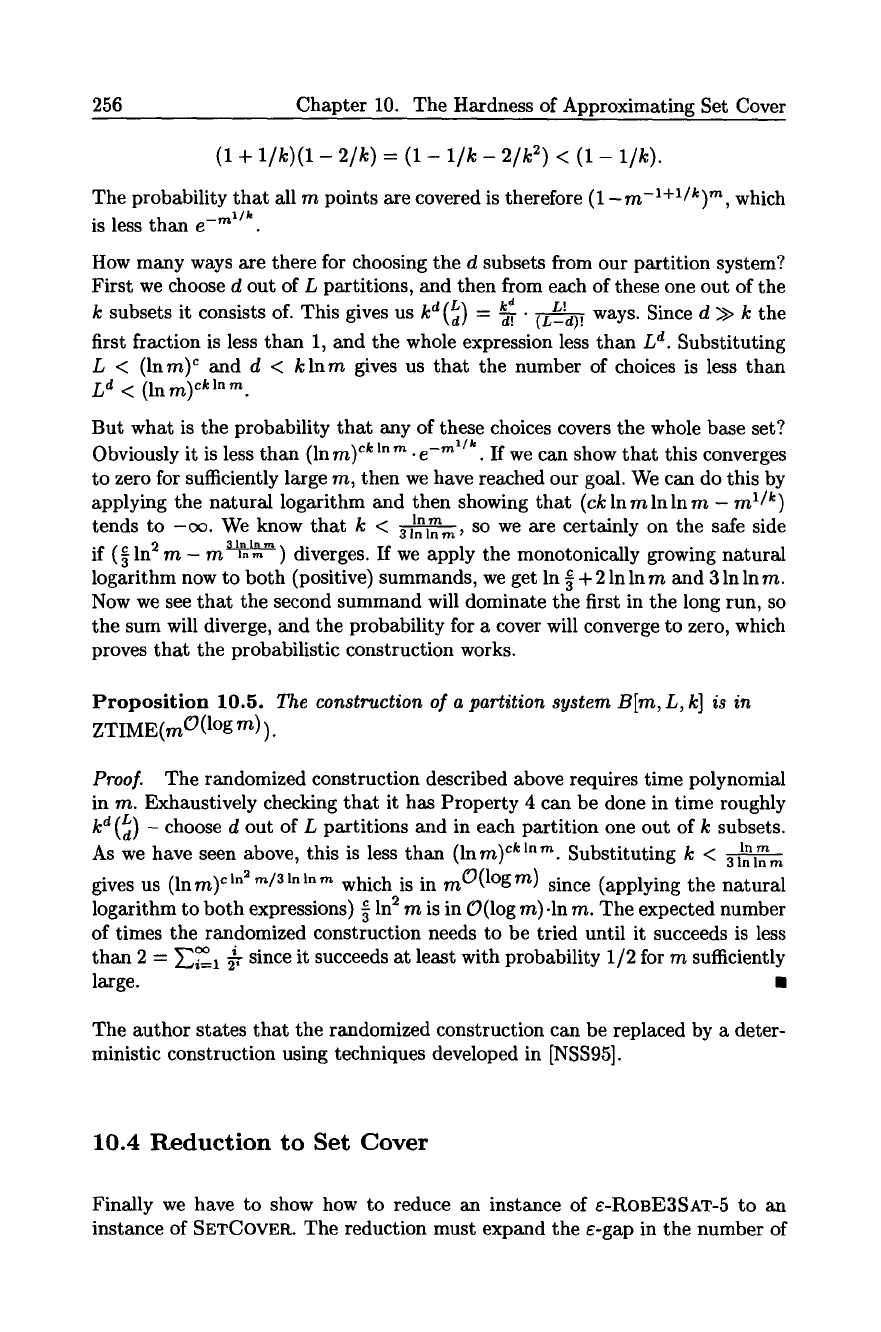
256 Chapter 10. The Hardness of Approximating Set Cover
(1 + l/k)(1 -
21k) =
(1 -llk
-
2/k 2) < (1 -
1/k).
The probability that all m points are covered is therefore (1-
m-l+l/k) m ,
which
is less than e -'~l/k.
How many ways are there for choosing the d subsets from our partition system?
First we choose d out of L partitions, and then from each of these one out of the
k subsets it consists of. This gives us
k d (Ld) = kd L!
-~. 9 ~ ways. Since d >> k the
first fraction is less than 1, and the whole expression less than L d. Substituting
L <(lnm) c and d <
klnm
gives us that the number of choices is less than
L d <2
(ln
m) ck
Inm.
But what is the probability that any of these choices covers the whole base set?
Obviously it is less than (ln m) ck In m. e-m 1/~" If we can show that this converges
to zero for sufficiently large m, then we have reached our goal. We can do this by
applying the natural logarithm and then showing that
(ck
ln mlnln
m
-m
l/k)
In m
tends to -oc. We know that k < 31~lnm' SO we are certainly on the safe side
31nlnm
if (~ In 2 m - m ~n,, ) diverges. If we apply the monotonically growing natural
logarithm now to both (positive) summands, we get In ~ + 2 In In m and 3 In In m.
Now we see that the second summand will dominate the first in the long run, so
the sum will diverge, and the probability for a cover will converge to zero, which
proves that the probabilistic construction works.
Proposition 10.5.
The construction
of a
partition system
B[m, L, k]
is in
ZTiME(mO(log m)).
Proof.
The randomized construction described above requires time polynomial
in m. Exhaustively checking that it has Property 4 can be done in time roughly
kd
(L) _ choose d out of L partitions and in each partition one out of k subsets.
In rn
As we have seen above, this is less than (In
m) ck In m.
Substituting k < 3 i-Shinto
gives us (Into) cln2 m/31nln m which is in mO(l~ m) since (applying the natural
logarithm to both expressions) c 2
In m is in O(log m)-ln m. The expected number
of times the randomized construction needs to be tried until it succeeds is less
than 2 = ~i~176 ~ since it succeeds at least with probability 1/2 for m sufficiently
large. 9
The author states that the randomized construction can be replaced by a deter-
ministic construction using techniques developed in [NSS95].
10.4
Reduction to Set
Cover
Finally we have to show how to reduce an instance of e-RosE3SAT-5 to an
instance of SETCOVEK. The reduction must expand the e-gap in the number of
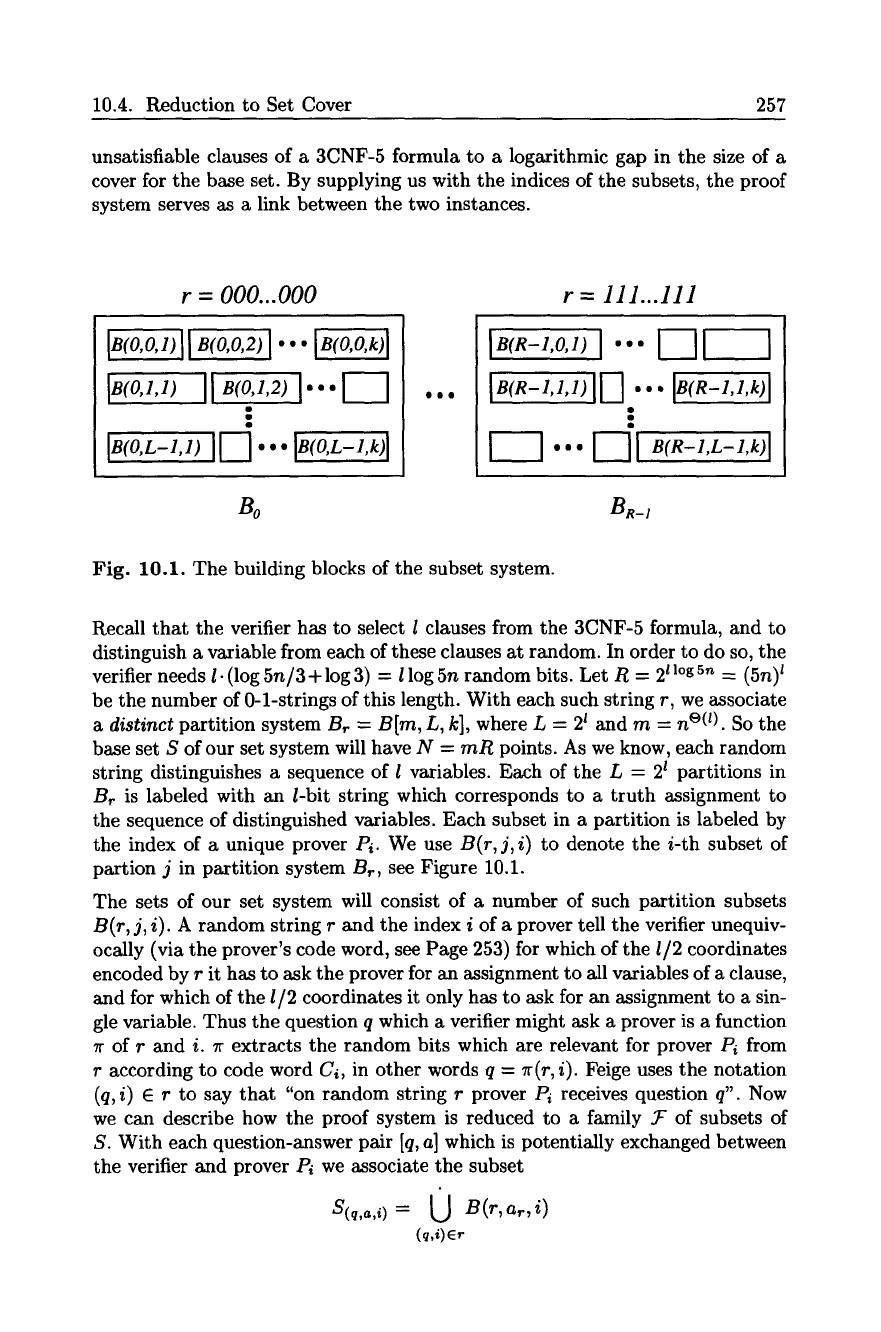
10.4. Reduction to Set Cover 257
unsatisfiable clauses of a 3CNF-5 formula to a logarithmic gap in the size of a
cover for the base set. By supplying us with the indices of the subsets, the proof
system serves as a link between the two instances.
r = 000...000
I
I I--i ""
Bo
OO0
r = 111...111
1 I"" DI "rR-','-l,k)l
I
BR-1
Fig. 10.1. The building blocks of the subset system.
Recall that the verifier has to select l clauses from the 3CNF-5 formula, and to
distinguish a variable from each of these clauses at random. In order to do so, the
verifier needs l- (log
5n/3 +log
3) = 1 log 5n random bits. Let R = 21 log 5n = (5n)t
be the number of 0-1-strings of this length. With each such string r, we associate
a distinct
partition system
Br = B[m, L, k],
where L -- 2 t and
rn = n ~ .
So the
base set S of our set system will have N =
mR
points. As we know, each random
string distinguishes a sequence of l variables. Each of the L = 2 t partitions in
Br is labeled with an/-bit string which corresponds to a truth assignment to
the sequence of distinguished variables. Each subset in a partition is labeled by
the index of a unique prover
Pi.
We use B(r, j,i) to denote the i-th subset of
partion j in partition system B~, see Figure 10.1.
The sets of our set system will consist of a number of such partition subsets
B(r, j, i). A random string r and the index i of a prover tell the verifier unequiv-
ocally (via the prover's code word, see Page 253) for which of the
1/2
coordinates
encoded by r it has to ask the prover for an assignment to all variables of a clause,
and for which of the
1/2
coordinates it only has to ask for an assignment to a sin-
gle variable. Thus the question q which a verifier might ask a prover is a function
7r of r and i. 7r extracts the random bits which are relevant for prover
Pi
from
r according to code word
Ci,
in other words q = 7r(r, i). Feige uses the notation
(q, i) E r to say that "on random string r prover
Pi
receives question q". Now
we can describe how the proof system is reduced to a family ~" of subsets of
S. With each question-answer pair [q, a] which is potentially exchanged between
the verifier and prover
Pi
we associate the subset
S(q,a,i) = ~J B(r,a~,i)
(q,i)e~

258 Chapter 10. The Hardness of Approximating Set Cover
where ar is a projection of the prover's answer a to the sequence of distinguished
variables. For each clause for which the prover is supposed to answer with a
truth assignment to all of its three variables, this projection simply ignores the
assignments to the two variables which were not distinguished. Note that the
prover's index i in S(q,a,i) is redundant since it can be deduced from the question
q and the code words, but used nevertheless for clarity.
Let Q denote the number of possible different questions that a prover may re-
ceive. A question to a single prover includes 1/2 variables, for which there are
n z/~ possibilities (with repetition), and l/2 clauses, for which there are (5n/3) ~/2
possibilities. Hence Q = n 1/2 9 (5n/3) 1/2. Observe that this number is the same
for all provers.
The following key lemma exploits the fact that the reduction above produces
subset families which depend strongly on the answers of the provers. The idea
is that if a formula ~ is satisfiable, then there is a strategy for the provers to
answer consistently, and the subsets corresponding to these answers fit nicely
together. They will even be disjoint, hence few are needed to cover the base set.
If however ~ is not satisfiable, we will use a probabilistic argument to show that
approximately by a logarithmic factor more sets are needed for a cover in the
subset system to which ~ is reduced in this case.
Lemxna 10.6. If ~o is satisfiable, then the base set S of N = mR points can be
covered by kQ subsets. I1 only a (1 - ~)-fraetion of the clauses in ~ is simul-
taneously satisfiable, S requires more than (k- 4)Qlnm subsets in order to be
covered. Thus the ratio between the two cases is at least (1 -4/k)lnm.
Proof. Suppose there is a satisfying truth assignment for ~. Fix a strategy for
the provers which is consistent with it. Let al,...,ak be the provers' answers
to the verifier's questions ql = ~(r, 1),..., qk = lr(r, k) with the notation used
above. Then for any random string r (i.e. no matter what the verifier asks),
these answers are consistent and map to the same assignment ar for the se-
quence of distinguished variables. Hence the sets S(q 1,a~,1),. .., S(q~,a~,k) contain
B(r, at, 1),..., B(r, at, k) and therefore cover Br. Since this holds for all random
strings, the collection of all subsets S(q,~,i), where a is the answer given by prover
Pi under the strategy above, covers the whole base set S. The number of sets
used is the product of k, the number of provers, and Q, the number of possible
questions to a single prover. These kQ subsets are disjoint.
Now consider the case that at most a (1 - e)-fraction of the clauses in ~o is
simultaneously satisfiable. Lemma 10.3 tells us that the provers have no strategy
which succeeds in convincing the verifier to accept with probability greater than
k 2 9 2 -c2t. Assume we had a cover C C_ Y of size (k - 4)Qlnm (i.e. just below
the logarithmic threshold). If we can find a strategy for the provers based on
this cover which succeeds with a probability that is greater than Lemma 10.3
allows, then we have the contradiction needed.

10.4. Reduction to Set Cover 259
We map our cover C back into a proof system. With each question q to a prover
Pi,
we associate a weight
Wq,i
which equals the number of answers a such that
S(q,~,i) E C.
Hence
~q,i wq,i = ICI.
Now with each random string r we associate
the weight Wr =
~-~(q,i)er Wq,i.
This weight equals the number of subsets that
participate in covering
Br
since
w~ = ~ ~,, = ~ I{a: S(~,.,,) e C} I = I{S(~,o,,) e C:
(q,i) ~
r}l.
(q,i)Er (q,i) Er
We say that a random string r is
good
if wr < (k - 2) In m.
Proposition
10.7.
Given a cover C of size (k- 4)Q lnm, the fraction of good
r is at least 2/k.
Proof.
Let G = {r : Wr /> (k-2) lnm} be the set of
bad
random strings.
Assume IGI > (1 -
2/k)R
where R is the number of possible random strings.
Then
Ew~ ~> E w~/>
(1-2/k)R. (1-2/k)klnm > (1-4/k)kRlnm
r rEG
On the other hand, using the definition of wr, we have
R R
r r (q,i)Er q,t
Recall that Q denotes the number of possible different questions that a prover
may receive. Then
R/Q
is the number of random strings which cause the verifier
to send a particular question q to a particular prover. This explains the second
equality. Putting the two lines above together, we get ICI > (k -4)Q lnm which
is a contradiction. 9
Proposition
10.8.
Given a cover C of size (k-
4)Qlnm.
Then there is a
strategy for the provers such that the verifier accepts ~ with probability at least
8/(k 3
In 2 m).
Proof.
We will show that the following simple random strategy which is based
on the assumed cover C succeeds with the desired probability.
On receiving question q,
Pi
selects an answer a uniformly at random
from the set of answers that satisfy
S(q,a,i ) E
C.
For a fixed random string r there is a one-to-one correspondence between the sets
B(r,p, i)
which participate in the cover of Br, and sets
S(q,a,i)
that belong to C:
on the one hand, it is clear that a set
S(q,~,i)
contains at most one
B(r,p, i)
from
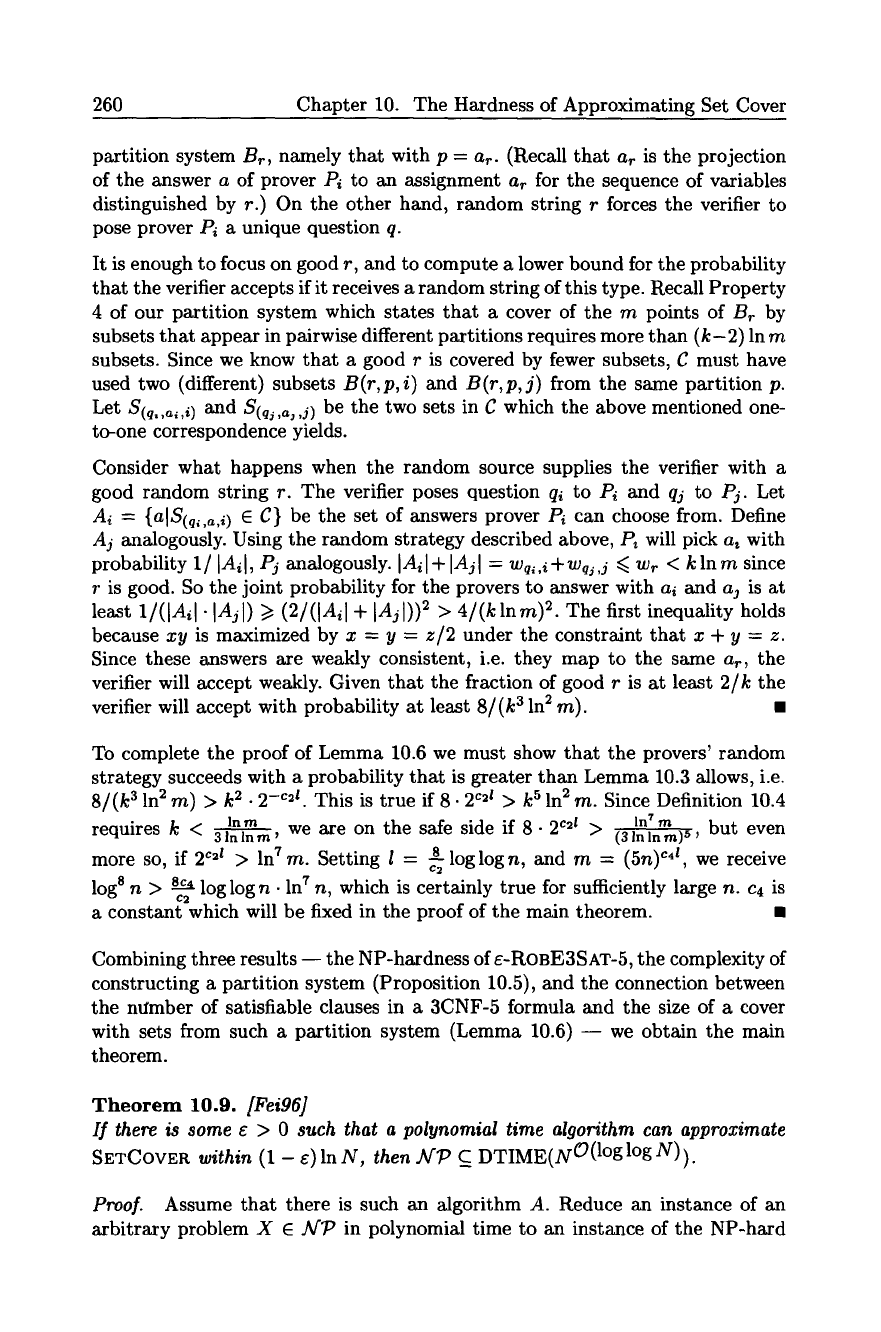
260 Chapter 10. The Hardness of Approximating Set Cover
partition system Br, namely that with p = at. (Recall that ar is the projection
of the answer a of prover Pi to an assignment ar for the sequence of variables
distinguished by r.) On the other hand, random string r forces the verifier to
pose prover Pi a unique question q.
It is enough to focus on good r, and to compute a lower bound for the probability
that the verifier accepts if it receives a random string of this type. Recall Property
4 of our partition system which states that a cover of the m points of B~ by
subsets that appear in pairwise different partitions requires more than (k-2) Inm
subsets. Since we know that a good r is covered by fewer subsets, r must have
used two (different) subsets
B(r,p, i)
and
B(r,p,j)
from the same partition p.
Let S(q,,~,~) and S(q~,a, ,5) be the two sets in C which the above mentioned one-
to-one correspondence yields.
Consider what happens when the random source supplies the verifier with a
good random string r. The verifier poses question qi to P~ and qj to Pj. Let
As ~- {alS(q,~,i) E C}
be the set of answers prover P~ can choose from. Define
Aj analogously. Using the random strategy described above, P, will pick a~ with
probability 1 / I A~I, Pj analogously.
I Ail + I Aj I = Wq,,i + Wq~,j <~ Wr < k
In m since
r is good. So the joint probability for the provers to answer with a~ and a~ is at
least
1/(IAi I 9 IAjl) >1
(2/(IAi ] + IAjl)) 2 >
4/(k
Into) 2. The first inequality holds
because
xy
is maximized by x = y =
z/2
under the constraint that x + y = z.
Since these answers are weakly consistent, i.e. they map to the same
ar,
the
verifier will accept weakly. Given that the fraction of good r is at least
2/k
the
verifier will accept with probability at least 8/(k 3 In 2 m). 9
To complete the proof of Lemma 10.6 we must show that the provers' random
strategy succeeds with a probability that is greater than Lemma 10.3 allows, i.e.
8/(k 3 In 2 m) > k 2 9 2 -c21. This is true if 8.2 c2~ > k s In 2 m. Since Definition 10.4
In m
In T m but even
requires k < 3 Zn zn rn' we are on the safe side if 8 9 2 c21 > (3 zn In m)5,
more so, if 2 c2t >lnTm. Setting I = ~loglogn, and m = (hn) c4t, we receive
log 8 n > ~ log log n 9 In 7 n, which is certainly true for sufficiently large n. c4 is
C2
a constant which will be fixed in the proof of the main theorem. 9
Combining three results -- the NP-hardness of c-ROBE3SAT-5, the complexity of
constructing a partition system (Proposition 10.5), and the connection between
the ntfmber of satisfiable clauses in a 3CNF-5 formula and the size of a cover
with sets from such a partition system (Lemma 10.6) -- we obtain the main
theorem.
Theorem 10.9.
[Fei96]
If there is some ~ > 0 such that a polynomial time algorithm can approximate
SETCOVER
within
(1 - e)lnN,
then AfT~ C DTIME(NO(l~176 N)).
Proo].
Assume that there is such an algorithm A. Reduce an instance of an
arbitrary problem X E AlP in polynomial time to an instance of the NP-hard
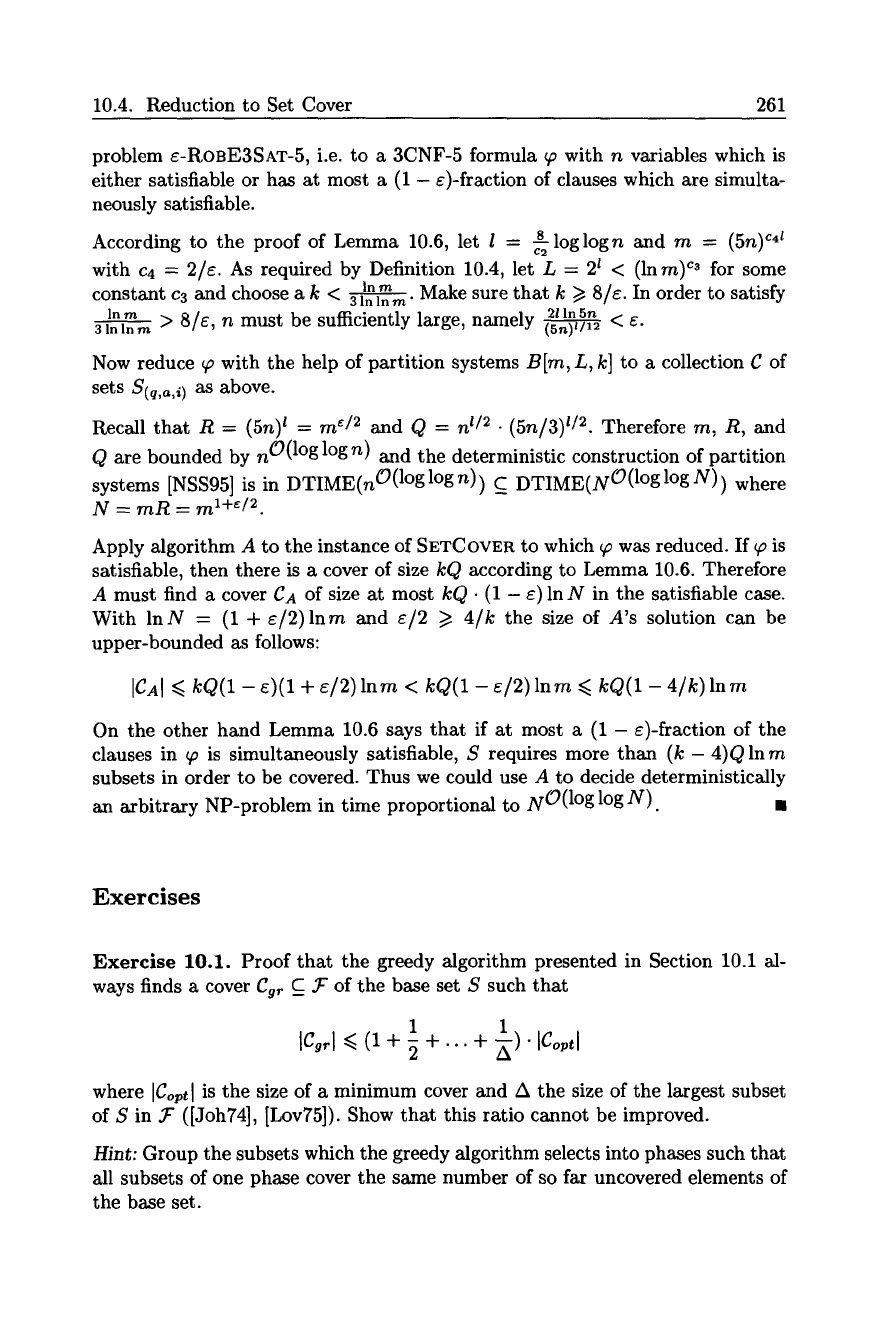
10.4. Reduction to Set Cover 261
problem e-ROBE3SAT-5, i.e. to a 3CNF-5 formula ~ with n variables which is
either satisfiable or has at most a (1 - e)-fraction of clauses which are simulta-
neously satisfiable.
According to the proof of Lemma 10.6, let I = ~loglogn and m = (5n) c41
with c4 -- 2/e. As required by Definition 10.4, let L -- 21 < (ln m) c3 for some
In m . Make sure that k/> 8/e. In order to satisfy
constant c3 and choose a k < 3 In Inm
21 In 5n
lnm >
8/e, n must be sufficiently large, namely ~ < e.
3 lnlnm
Now reduce ~ with the help of partition systems B[m, L, k] to a collection C of
sets S(q,a,i) as above.
Recall that R = (5n) t = rn ~/2 and Q = n~/2 9 (5n/3)l/2. Therefore m, R, and
Q are bounded by nO( l~ log n) and the deterministic construction of partition
systems [NSS95] is in DTIME(nO(I~ log n)) C_ DTIME(NO(I~ log N)) where
N = mR = m 1+~/2.
Apply algorithm A to the instance of
SETCOVER
to which ~ was reduced. If ~ is
satisfiable, then there is a cover of size kQ according to Lemma 10.6. Therefore
A must find a cover CA of size at most kQ 9 (1 - e) In N in the satisfiable case.
With lnN= (1 + e/2)lnm and e/2 >1 4/k the size of A's solution can be
upper-bounded as follows:
ICAJ
<<.
kQ(1 -e)(1 + e/2)lnm < kQ(1 -e/2)lnm x< kQ(1 -4/k)lnm
On the other hand Lemma 10.6 says that if at most a (1 - e)-fraction of the
clauses in ~o is simultaneously satisfiable, S requires more than (k -4)Qlnm
subsets in order to be covered. Thus we could use A to decide deterministically
an arbitrary NP-problem in time proportional to NO( l~ log N). 9
Exercises
Exercise 10.1. Proof that the greedy algorithm presented in Section 10.1 al-
ways finds a cover Cgr C_ jr of the base set S such that
1 1
IC~rl ~< (1+ ~ +... + ~)-LCop~l
where ]Cop,] is the size of a minimum cover and A the size of the largest subset
of S in ~- ([Joh74], [Lov75]). Show that this ratio cannot be improved.
Hint: Group the subsets which the greedy algorithm selects into phases such that
all subsets of one phase cover the same number of so far uncovered elements of
the base set.
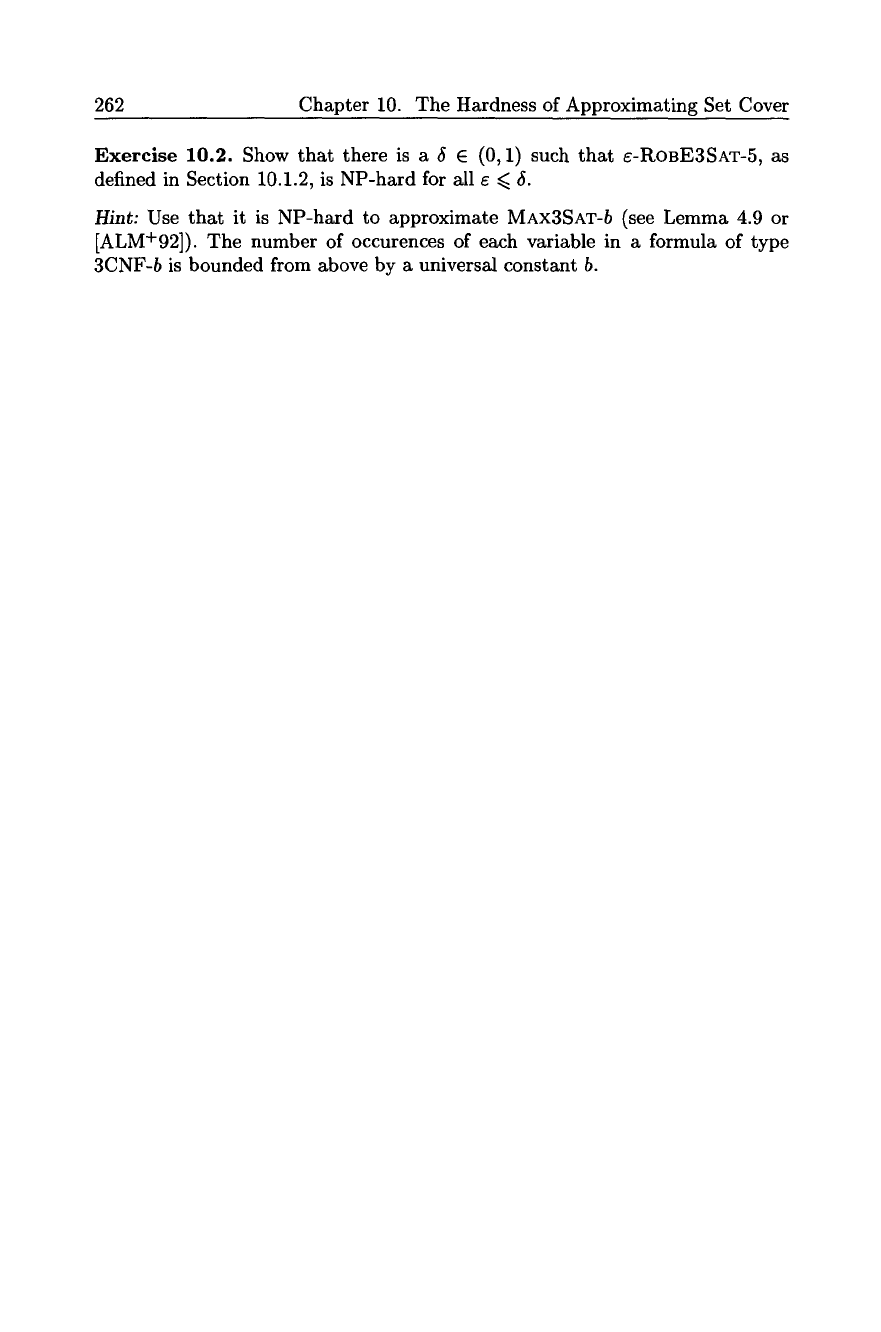
262 Chapter 10. The Hardness of Approximating Set Cover
Exercise 10.2. Show that there is a 5 E (0, 1) such that e-ROBE3SAT-5, as
defined in Section 10.1.2, is NP-hard for all e ~ 5.
Hint: Use that it is NP-hard to approximate MAX3SAT-b (see Lemma 4.9 or
[ALM+92]). The number of occurences of each variable in a formula of type
3CNF-b is bounded from above by a universal constant b.

11. Semidefinite Programming and Its
Applications to Approximation Algorithms
Thomas Hofmeister ~, Martin H/lAne
11.1 Introduction
AfrO-hard problems are often tackled using the relaxation method approach. The
idea of this approach is to add or remove conditions to or from the original
problem in such a way that the solution space is enlarged. The hope is that
the new solution space will be more smooth in the sense that it allows a more
efficient, i.e., polynomial-time, computation of the optimum.
One possibility of applying this method lies in computing upper or lower bounds
within a branch-and-bound approach. Let us assume that we are dealing with a
maximization problem. Since the modified solution space contains the original
solution space as a subset, the optimal solution to the relaxed problem is an
upper bound to the optimum of the original problem.
Known examples for problems which can be treated in this way include the
KNAPSACK problem. Given n objects with size cj and value tj, we want to
fill a knapsack such that its value is maximized. This is an AfT)-hard problem,
but if we are allowed to take fractional parts of the objects, then we can solve
the problem in polynomial time, using a greedy algorithm. The greedy solution
provides us with an upper bound for the original KNAPSACK problem.
One can also try to apply some transformation (often called "rounding") to
a solution of the relaxed problem in order to obtain a good solution for the
original problem. The quality of the so obtained solution can then be estimated
by comparing it with the upper bound provided by the relaxed solution. There
are cases, like "totally unimodular" linear programs, where relaxations even yield
the optimal solutions, as is the case with the weighted matching problem.
The relaxation method can also be combined with semidefinite programs. Semi-
definite programming is a generalization of linear programming. It has been
studied for quite some time. For example, it is known that semidefinite programs
can be solved in polynomial time. The attention of algorithm designers has
turned to semidefinite programming only recently. This is due to a paper by
Goemans and Williamson [GW95], where for several Af:P-hard problems efficient
* This author was partially supported by the Deutsche Forschungsgemeinschaft as
part of the Collaborative Research Center "Computational Intelligence" (SFB 531).
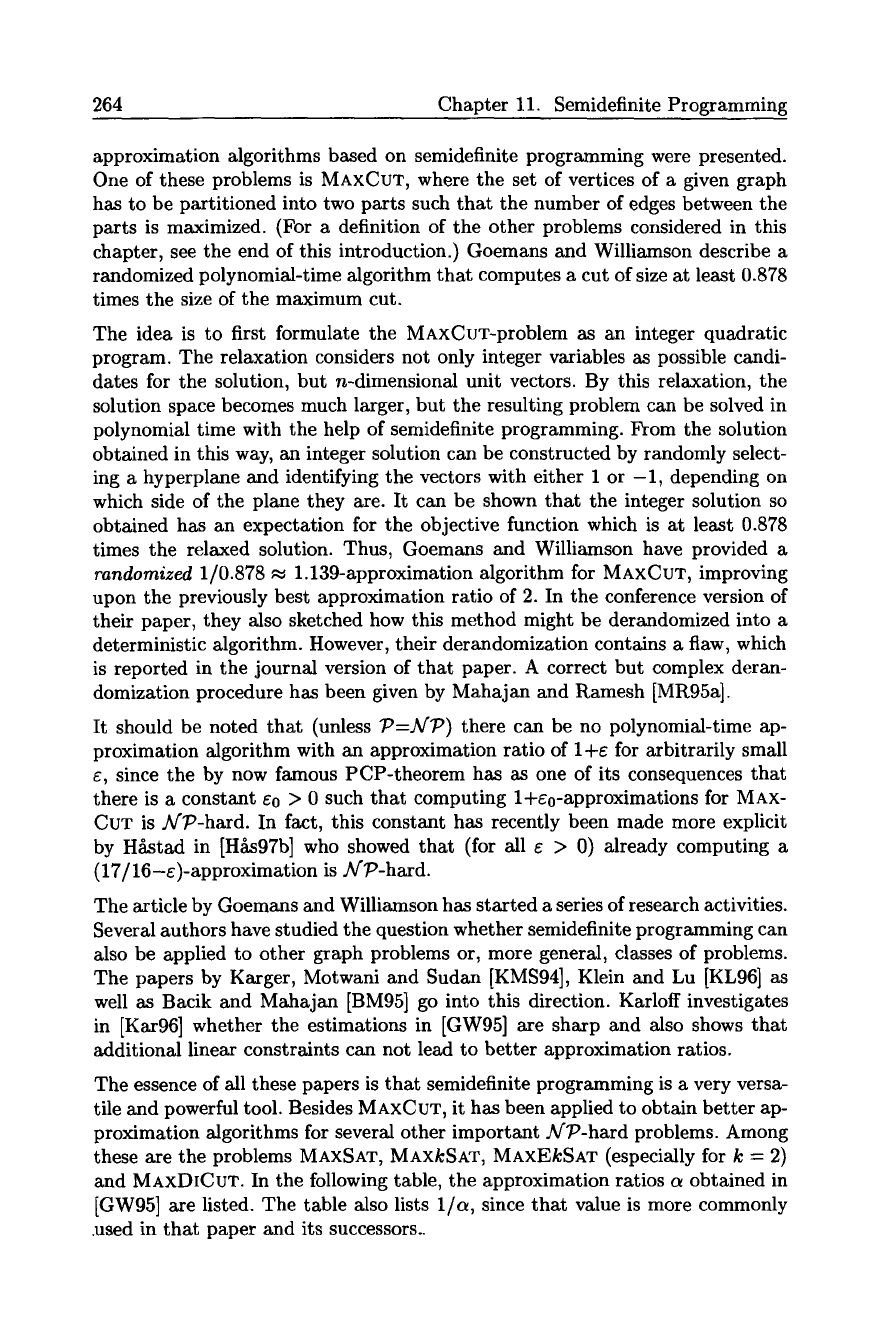
264 Chapter 11. Semidefinite Programming
approximation algorithms based on semidefinite programming were presented.
One of these problems is MAXCUT, where the set of vertices of a given graph
has to be partitioned into two parts such that the number of edges between the
parts is maximized. (For a definition of the other problems considered in this
chapter, see the end of this introduction.) Goemans and Williamson describe a
randomized polynomial-time algorithm that computes a cut of size at least 0.878
times the size of the maximum cut.
The idea is to first formulate the MAXCuT-problem as an integer quadratic
program. The relaxation considers not only integer variables as possible candi-
dates for the solution, but n-dimensional unit vectors. By this relaxation, the
solution space becomes much larger, but the resulting problem can be solved in
polynomial time with the help of semidefinite programming. From the solution
obtained in this way, an integer solution can be constructed by randomly select-
ing a hyperplane and identifying the vectors with either 1 or -1, depending on
which side of the plane they are. It can be shown that the integer solution so
obtained has an expectation for the objective function which is at least 0.878
times the relaxed solution. Thus, Goemans and Williamson have provided a
randomized
1/0.878 ~ 1.139-approximation algorithm for MAXCUT, improving
upon the previously best approximation ratio of 2. In the conference version of
their paper, they also sketched how this method might be derandomized into a
deterministic algorithm. However, their derandomization contains a flaw, which
is reported in the journal version of that paper. A correct but complex deran-
domization procedure has been given by Mahajan and Ramesh [MR95a].
It should be noted that (unless
7)=A/P)
there can be no polynomial-time ap-
proximation algorithm with an approximation ratio of l+e for arbitrarily small
e, since the by now famous PCP-theorem has as one of its consequences that
there is a constant eo > 0 such that computing l+e0-approximations for MAX-
CUT is A/:P-hard. In fact, this constant has recently been made more explicit
by H~stad in [Hs who showed that (for all e > 0) already computing a
(17/16-e)-approximation is A/P-hard.
The article by Goemans and Williamson has started a series of research activities.
Several authors have studied the question whether semidefinite programming can
also be applied to other graph problems or, more general, classes of problems.
The papers by Karger, Motwani and Sudan [KMS94], Klein and Lu [KL96] as
well as Bacik and Mahajan IBM95] go into this direction. Karloff investigates
in [Kar96] whether the estimations in [GW95] are sharp and also shows that
additional linear constraints can not lead to better approximation ratios.
The essence of all these papers is that semidefinite programming is a very versa-
tile and powerful tool. Besides MAXCUT, it has been applied to obtain better ap-
proximation algorithms for several other important A/P-hard problems. Among
these are the problems MAXSAT, MAXkSAT, MAxEkSAT (especially for k = 2)
and MAxDICuT. In the following table, the approximation ratios a obtained in
[GW95] are listed. The table also lists
1/a,
since that value is more commonly
.used in that paper and its successors..
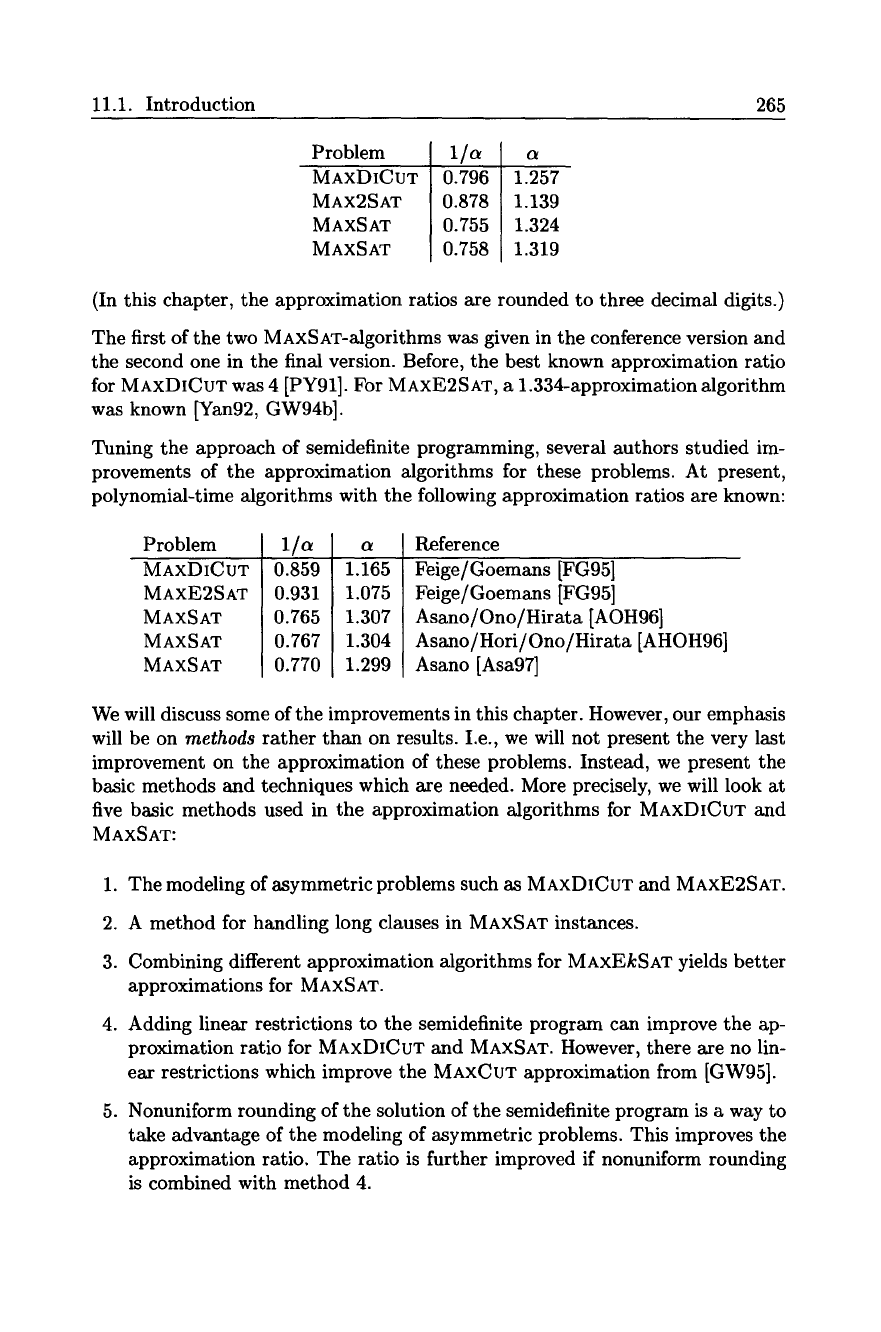
11.1. Introduction 265
Problem
MAxDICuT
MAX2SAT
MAXSAT
MAXSAT
0.796
0.878
0.755
0.758
1.257
1.139
1.324
1.319
(In this chapter, the approximation ratios are rounded to three decimal digits.)
The first of the two MAXSAT-algorithms was given in the conference version and
the second one in the final version. Before, the best known approximation ratio
for MAxDICUT was 4 [PY91]. For MAxE2SAT, a 1.334-approximation algorithm
was known [Yan92, GW94b].
Tuning the approach of semidefinite programming, several authors studied im-
provements of the approximation algorithms for these problems. At present,
polynomial-time algorithms with the following approximation ratios are known:
Problem
MAxDICuT
MAXE2SAT
MAXSAT
MAXSAT
MAXSAT
0.859
0.931
0.765
0.767
0.770
1.165
1.075
1.307
1.304
1.299
Reference
Feige/Goemans [FG95]
Feige/Goemans [FG95]
Asano/Ono/Hirata [AOH96]
hsano/Hori/Ono/Hirata [AHOH96]
hsano [Asa97]
We will discuss some of the improvements in this chapter. However, our emphasis
will be on
methods
rather than on results. I.e., we will not present the very last
improvement on the approximation of these problems. Instead, we present the
basic methods and techniques which are needed. More precisely, we will look at
five basic methods used in the approximation algorithms for MAxDICUT and
MAXSAT:
1. The modeling of asymmetric problems such as MAXDICUT and MAXE2SAT.
2. A method for handling long clauses in MAXSAT instances.
3. Combining different approximation algorithms for MAxEkSAT yields better
approximations for MAXSAT.
4. Adding linear restrictions to the semidefinite program can improve the ap-
proximation ratio for MAxDICuT and MAXSAT. However, there are no lin-
ear restrictions which improve the MAXCUT approximation from [GW95].
5. Nonuniform rounding of the solution of the semidefinite program is a way to
take advantage of the modeling of asymmetric problems. This improves the
approximation ratio. The ratio is further improved if nonuniform rounding
is combined with method 4.
